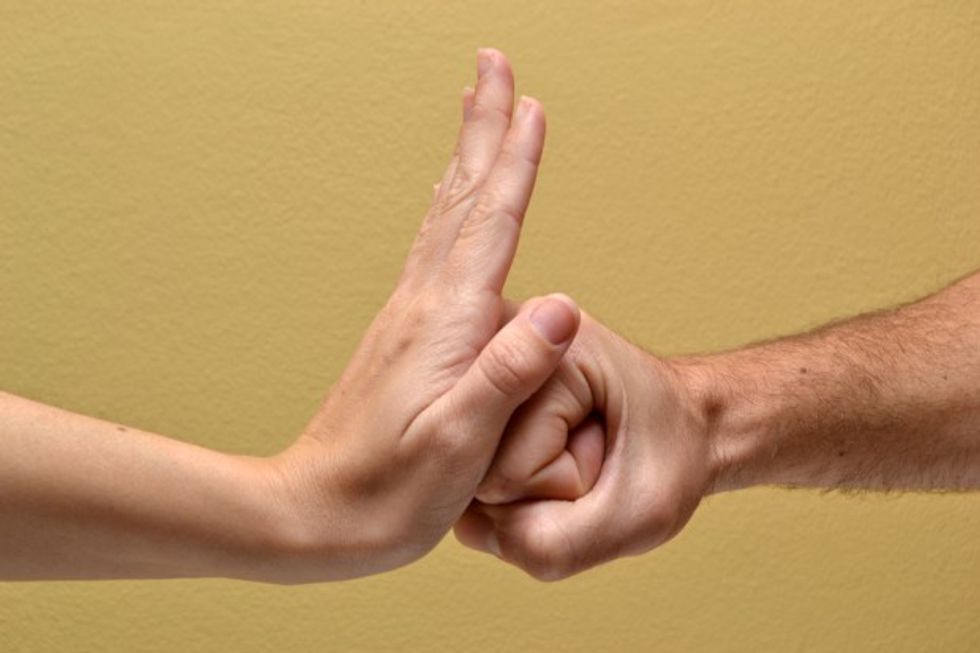
Photo credit: Shutterstock

Cadaver arms, fishing line and padded dumbbells.
That's what scientists at the University of Utah used to study how the human hand might have evolved, in part, to give a good punch.

"The idea that aggressive behavior played a role in the evolution of the human hand is controversial," biology professor David Carrier with the university said in a statement. "Many skeptics suggest that the human fist is simply a coincidence of natural selection for improved manual dexterity. That may be true, but if it is a coincidence, it is unfortunate.
"As an alternative, we suggest that the hand proportions that allow the formation of a fist may tell us something important about our evolutionary history and who we are as a species," Carrier continued. "If our anatomy is adapted for fighting, we need to be aware we always may be haunted by basic emotions and reflexive behaviors that often don't make sense — and are very dangerous — in the modern world."
While the most popular scientific theory is that the human hand evolved to allow for enhanced dexterity to hold tools, Carrier et al. believe that the hand — and face of a human ancestor for that matter — also evolved to give (and take) a hit.
To test this theory, the researchers used eight cadaver arms to conduct hundreds of slaps and punches. Here's how, according to the university's news release:
The experiment's cadaver arms were placed in a pendulum-like apparatus so they could swing toward and punch a padded, force-detecting dumbbell with either a clenched or buttressed fist (thumb locked around index and middle fingers, which are curled tightly to the palm) or an unbuttressed fist (thumb outward and not touching the loosely folded fingers) or side-slap the target with an open hand.The cadaver hands were placed in those positions with fishing line tied to tendons of forearm muscles. Those tendons pull various muscles that control the wrist, thumb and fingers. Guitar-tuner knobs controlled tension on the fishing lines to adjust the hands.

The researchers found that the closed hand could strike with 55 percent more force, compared to a slightly open hand with loosely bent fingers. A fist struck with twice as much force compared to an open-handed slap, the researchers stated in the study published this week in the Journal of Experimental Biology.
"Thus, the evolutionary significance of the proportions of the hominin hand may be that these are the proportions that improved manual dexterity while at the same time making it possible for the hand to be used as a club during fighting," the study authors wrote.
The news release from the university included criticism of Carrier's hypothesis that the hand evolved, in part, to partake in fistfights. Some of this included a lack of evidence that human ancestors engaged in fistfights and the theory that humans are, by nature, more empathetic than aggressive.
To these, Carrier said while humans are indeed empathetic by nature, he thinks aggression still was involved in human evolution and, he noted, that he believes there is evidence of fistfights in the prehistoric record.
Other criticism focuses on the body structure itself. Those who counter Carrier's hypothesis argue about the delicate nature of the face and the hand.
Carrier said that while modern humans, yes, might be more delicate, their ancestors — the australopiths — were of heartier stock, with larger, flatter faces and bigger upper bodies.
"As our face became less massive, we also lost punching power," Carrier said of Homo sapiens.
The Washington Post has more on criticism about his hypothesis:
Arizona State University's Mary Marzke was unimpressed with the hypothesis, pointing out that chimps and gorillas do manage "fist-like" grabbing gestures, even if they don't have thumbs long enough to make a true human fist. These animals don't use their half-fists for fighting, but for breaking up food."It also is surprising that the authors compared fist-punching with palm-slapping, instead of with striking by the heel of the palm," Marzke told The Post. "The latter is well known to be very effective in fighting. It has the advantage of concentrating force over a relatively small area of the hand, an advantage that the author highlighted for the fist in an earlier study. The palm heel punch does not require hominin thumb and finger proportions."
Brigitte Demes of Stony Brook University was also critical of the study, suggesting that the data didn't really prove anything one way or another — it just fit the narrative Carrier likes.
Carrier told the Washington Post that he believes the form of the hand evolving in order to hold tools "makes perfect sense," but he added "what we’re suggesting is that maybe there’s another component."
He also told the Post that he thinks some criticism of his work comes out of fear, "fear that evidence suggesting we’re anatomically built for fighting could be used to justify bad behavior."
—
Front page image Shutterstock.com.